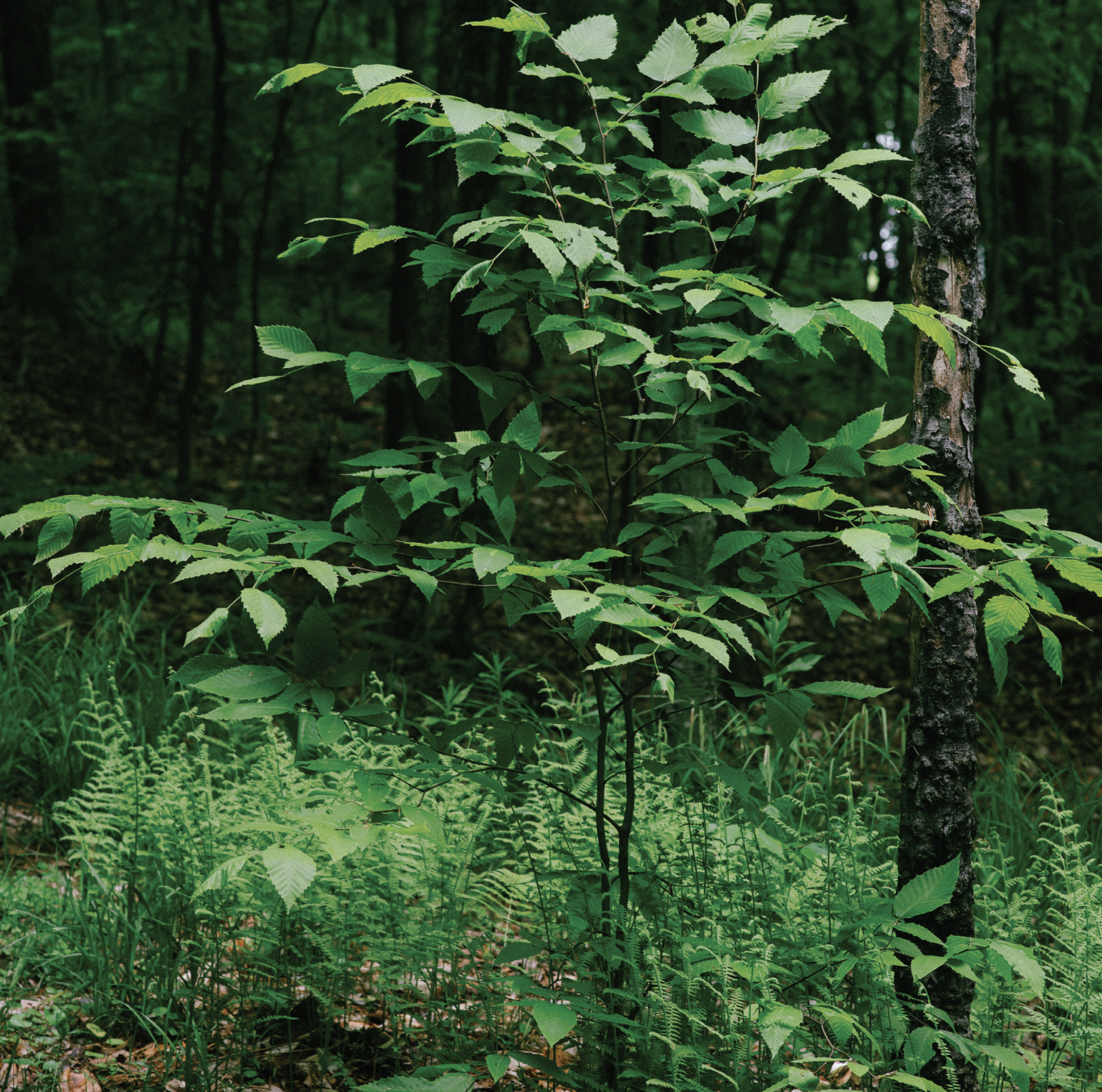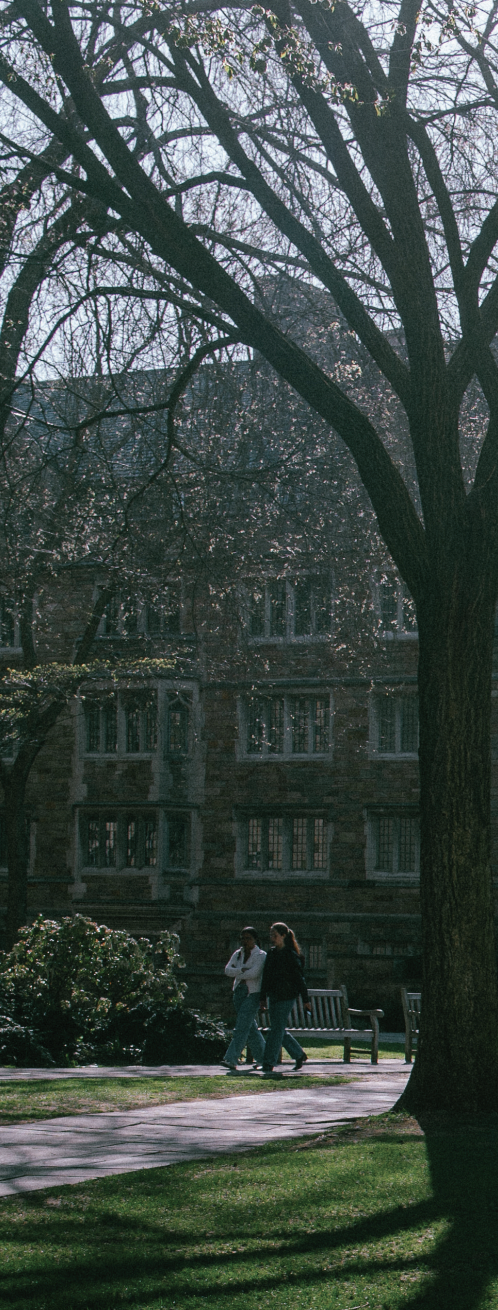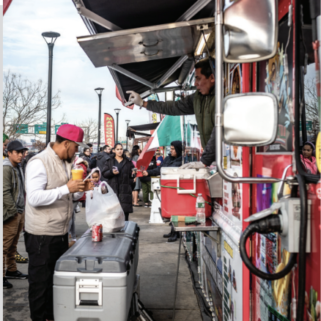Yale’s land acknowledgement promises to recognize the displaced indigenous peoples of Connecticut, but not everyone is convinced.
I.
“Yale University acknowledges that indigenous peoples and nations, including Mohegan, Mashantucket Pequot, Eastern Pequot, Schaghticoke, Golden Hill Paugussett, Niantic, and the Quinnipiac and other Algonquian speaking peoples, have stewarded through generations the lands and waterways of what is now the state of Connecticut. We honor and respect the enduring relationship that exists between these peoples and nations and this land.”
The first time she heard Yale’s land acknowledgment, Nyché Andrew ’25, a Yup’ik and Inupiaq student from Alaska, felt confused. She was attending an online first-year orientation meeting about how Yale students could be respectful residents of New Haven. Nyché felt the statement lacked any sort of urgency and wondered if other students were even paying attention. As she heard the acknowledgment read again at various Yale events, her confusion sharpened to frustration. “The syntax, by using ‘has stewarded,’ refuses to be more present about Native peoples’ relation to land today,” she tells me. “By ignoring Yale’s active harm against Native people, [the statement] goes into erasure.”
Yale adopted their current land acknowledgment in October 2019. Out of the three Indigenous professors and six Indigenous students I talked to, none of them knew how or why the statement was drafted. None of the six University administrators, each a part of the secretary office that issued the statement, returned my emails asking for more information. On the website of the Office of the Secretary and Vice President for Student Life, where the statement is published, there is no specific policy about where it ought to be recited; the website simply notes that the statement is “approved university language” that may be used at events.
While several students and professors I spoke with pointed to the importance of land acknowledgments as a practice, many feel that Yale’s current statement falls short of meaningful action. For Nyché, Yale’s statement raises more questions than it answers. How have these people stewarded the land? Do they still? And how does Yale “honor and respect” them, apart from sometimes reading their names aloud?
II.
I drive past the Quinnipiac River, past Sachem’s Head, past North Guilford, past Old Saybrook—all letters on a green sign beside the I-95 tarmac—and find myself at the Mashantucket Pequot Museum and Research Center.
Each of these names means something else to Connor Smith.
Smith’s wife and stepchildren are Mashantucket Pequot, and he spends his days as an educator working under the huge pine and oak trees of the Mashantucket Pequot Museum. Raised in Branford and New Haven, Smith grew up on soil cared for by the Quinnipiac. I knew the Quinnipiac people lived in Southern Connecticut before British colonists arrived in New Haven—Yale’s current land acknowledgment states as much. But Smith tells me that “much of what people know about the Quinnipiac is misunderstood.” He grins, pulls up a map of New Haven on his phone, and proceeds to tell me some history.

The Quinnipiac land spanned much of what we now know as the New Haven area; interrelated bands inhabited neighboring villages in what is now East Haven, Branford, and the northern part of New Haven. After the British had established themselves as the politically dominant force in the area with the Treaty of Hartford, Theophilus Eaton and John Davenport—the English founders of New Haven—created the Momauguin Treaty. The 1638 Treaty ascribed total agency to the Quinnipiac principal sachem, Momauguin, to sell the land without consulting the sachems of other Native bands. The Quinnipiac were then pushed onto a 1,200-acre parcel, the only land where they could plant, hunt, or build without English permission—one of the first forms of a reservation in the United States.
By the seventeenth century, colonists encroached upon the reservations as Quinnipiac people sold tracts and rights to pay for exorbitant petty crime fines, leading to recurrent conflicts over the boundaries of the reservation. In 1731, nearly all of the Quinnipiac reservation had been bought by colonists and most of the Quinnipiac emigrated to nearby Connecticut towns, far from the river they called home. Many Quinnipiac descendents, looking to preserve their sense of independence, joined the Brothertown movement later in the 18th century. They went west, converting to Christianity and settling in Wisconsin. Others joined different nearby tribes, including the Pequot. The Quinnipiac no longer exist as a recognized community though their descendants live on.
On his phone, Smith zooms in on Cross Campus, right by Harkness Hall. “If you’re talking about where Yale is, in the New Haven region, these were traditionally hunting grounds.” New Haven served as a shared land for the Quinnipiac bands, a living space for them to listen to the natural world.
Nakai Northup, the head educator at the museum and a member of the Mashantucket Pequot and Narragansett tribes, sustains his connection to the land through far more than twenty seconds of a land acknowledgment. “The land is my therapist,” he says, patting the dirt beneath us. He refers to it as his “close friend,” a being that he continually spends time with, one that frustrates him, one that partners with him through life.
“We’ve been here for two thousand-plus years, so that’s a long time to form a relationship,” Northup says. He can identify the plants around us by their Algonquian name.
When he looks out, he sees details that I cannot. And that gaze was forged through time—his and the generations before him.
He tells me about hunting for an animal, an act that Connecticut land sustained for thousands of years. “You can learn how [an animal] built a relationship with the land and the things that it relies on within the land and how the land relies on it for other things. And then you throw yourself in that mix. I guess that puts me in that cycle as well.” The kinship between the earth and Northup animates his stories.
Driving back, I turn on my GPS and return toward New Haven. The maps, trees, and signs grow richer than on my drive there. The Quinnipiac River was where they found their food. Sachem’s Head came from an old tale about a tribal conflict. And Saybrook was where the Pequot War culminated. Behind each of these names dwells a richness of the land, easy to overlook when driving, but clearer to see after talking with Northup and Smith.
III.
Back at Yale, I walk into the Native American Culture Center (NACC) and am greeted by the house staff, peer liaisons, and NACC Director and Assistant Dean of Yale College Matthew Makomenaw, all seated at a long table by the entrance. Bright colors surround them—construction paper, markers, candy wrappers, bowls, wall art. Each person is writing welcome letters to recently admitted Indigenous students. Their laughs and excitement flow into pages of kind words.

“First and foremost, we’re a student center, a place for Indigenous students to center themselves and find resources,” says Makomenaw, one of the Grand Traverse Bay Band of Ottawa and Chippewa people. “Even though we don’t all come from the same tribal nation or culture, we build a place where people are comfortable, and they have friendships, and they have mentorship, and they have a space that they can center themselves.”
Later that day, I speak with Naima Blanco-Norberg ’25, an Indigenous Mexican Arts Liaison, sitting on a couch in the library, cradled by books, maps, and portraits of Henry Roe Cloud, the first recognized Indigenous Yale graduate. She nods to a large map on the wall which shows the layout of different nations in North America. “It’s little things like that,” she tells me, “the books and the art which make a tie to indigeneity centered in this space, even though it’s a community of so many different communities.” As we leave, I pass by an activities room. To the left, a long table stands, with thousands of beads in boxes beside. “We get funding for them every year, and it’s a good activity since it’s something so many of us share,” says Megan Blackwell ’25, a Chickasaw Peer Liaison. With beads, pow-wows, and conferences spanning back to the nineteen-eighties, the Indigenous community at Yale has forged their own traditions.
Yale’s current land acknowledgment makes a small gesture towards the existence of these living communities but fails to do more than name them. “A land acknowledgment isn’t just something you say,” Megan tells me. “It has to be something you commit to. You have to commit to teaching these histories.”
What would it mean for the words in Yale’s land acknowledgment to signify anything more than just names? Discomfort is an essential part of a land acknowledgment, Tarren Andrews, assistant professor of Ethnicity, Race, and Migration, says. “Commitments allow for institutional land acknowledgments to go beyond their affective potential,” she tells me. “Acknowledgments are a way to make institutions that care a lot about performance put money behind the performance.” An unsettling land acknowledgment can sow the seeds of discomfort to spur institutional action.
To Northup and Andrews, a land acknowledgment should spawn an institutional relationship grounded in mutual care. Northup told me about other institutions, like the University of Connecticut, where administrators visited the Mashantucket Pequot museum and spoke with staff while drafting their land acknowledgement. Administrators and museum staff shared meals. Beyond writing their statement in dialogue with Indigenous educators, the University of Connecticut committed to hiring Indigenous faculty and partnered with the museum to create educational programs that centered Indigenous relationships to land.

Last year, Nyché presented a detailed proposal to the Yale College Council to support the creation of a Native and Indigenous Studies major, along with the development of more Indigenous studies courses and hiring of more Indigenous faculty. Megan and Andrews have each articulated the importance of all Yale College students learning the Indigenous history of this land, something embedded in the other land acknowledgments like those of the University of Colorado Boulder and Cornell University, which provide detailed educational resources about local Indigenous groups.
Several departments of Yale have created their own land acknowledgments or have begun their own relationships with Indigenous communities. The School of Architecture presents a map of Indigenous nations and recognizes Yale’s harm, albeit passively and in the past, by noting that Yale has “benefitted from lands gained through fulfilled and unfulfilled articles of agreement with Indigenous nations,” and commits to “imagine endless possibilities for architectures of reconciliation, reciprocity and transformation.” Northup told me that the students from the School of the Environment have visited the Mashantucket Pequot Museum, seeking to learn about Indigenous relationships with natural resources. To Northup and Andrews, these are the kinds of actions that a good land acknowledgment should spark.
Last year, Nyché, along with others in the NACC, wrote a new land acknowledgment. The first paragraph of the statement reads as follows:
Yale University is located on the lands of the Mohegan, Mashantucket Pequot, Eastern Pequot, Schaghticoke, Golden Hill Paugussett, Niantic, and the Quinnipiac and other Algonquian peoples and nations, who steward the lands and waterways through generations and time immemorial. We acknowledge the strenuous history of land dispossession that Yale benefits from and the enduring relationship between these peoples, nations, and land from this history. We call upon all to be aware of the Indigenous peoples, cultures, and histories of the land you occupy by learning about the efforts of Indigenous people to reclaim sovereignty and stewardship of their lands and communities. These original stewards are the past, present and future caretakers of the land and we want to honor them.
The statement asks for a new institutional and personal tradition. These words float around in the communities closest to the NACC, but Yale administration has yet to acknowledge it.
– Tashroom Ahsan is a sophomore in Davenport College and a Design Editor of The New Journal.


